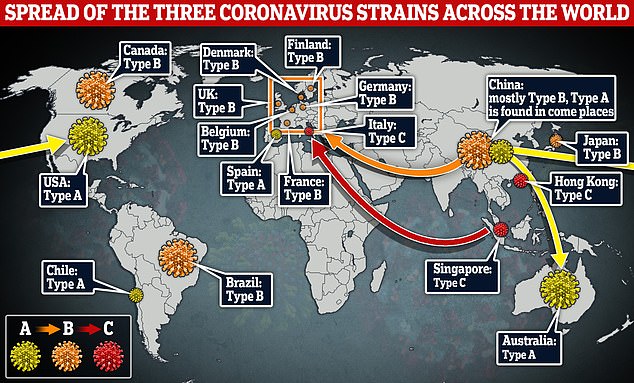Three distinct strains of the Novel Coronavirus
There are 3 distinct strains of the novel coronavirus in the world and while China's epidemic was driven by an early mutation that quickly spread in the UK, the US is suffering from an original variation. Scientists believe the virus officially called SARS-CoV-2 is constantly mutating to overcome immune system resistance in different populations.
Types of Coronavirus Strains
- Type A is closest to the one found in bats and pangolins and has two sub-clusters. One sub-cluster linked to Wuhan and the other is common in US and Australia.
- Type B is derived from type A and has become the most prevalent in Wuhan.
- Type C is the 'daughter' of type B and was spread to Europe via Singapore.
Three types of the deadly coronavirus are spreading around the world - and the US is being rocked by the original strain from China.

Cambridge University researchers mapped the genetic history of the infection from December to March and found three distinct, but closely related, variants.
Type A
Analysis of the strains showed type A - the original virus that jumped to humans from bats via pangolins - was not China's most common. Instead, the pandemic's ground-zero was mainly hit by type B, which was in circulation as far back as Christmas Eve.
Results showed type A was the most prevalent in Australia and the US, which has recorded more than 400,000 COVID-19 cases. Two-thirds of American samples were type A - but infected patients mostly came from the West Coast, and not New York.
Type B
Dr Peter Forster and team found the UK was mostly being bombarded with type B cases, with three quarters of samples testing as that strain. Switzerland, Germany, France, Belgium and the Netherlands were also dominated by type B.
Type C
Another distinct variation, type C, descended from type B and spread to Europe via Singapore.
Genetic History of Coronavirus
The genetic history of the coronavirus was mapped from December 24 to March 4, revealing three distinct, but closely related, variants. Scientists believe the virus may be constantly mutating to overcome differing levels of immune system resistance in different populations.

The study has thrown up an oddity that the original A strain spread through West Coast USA despite not being being the most prevalent in China, the B strain.
However because both strains were in existence by January, when US got its first case, it does not mean it arrived any earlier and was not detected. The researchers said the study was too small to draw any firm conclusions.
The academics' published work - which has been scrutinised by fellow scientists - only traced the samples of 160 patients across the world, including many of the first cases in Europe and the US.
Methods used to trace the prehistoric migration of ancient humans were adapted to track the spread of the SARS-CoV-2 virus, which causes COVID-19.
The team have now updated their analysis to include more than 1,000 COVID-19 cases up to the end of March to provide a clearer snapshot. It has not yet been peer-reviewed.
The smaller snapshot, published in the journal PNAS, initially suggested that type C was the most common in Europe.
But the data now shows type B is spreading more rampantly - all but one of 31 SARS-CoV-2 samples taken from patients in Switzerland were of the second cluster.
It comes after two separate genetic studies found most of New York's outbreak came from Europe, and revealed the infection was being spread in mid-February - weeks before the city's first confirmed case.